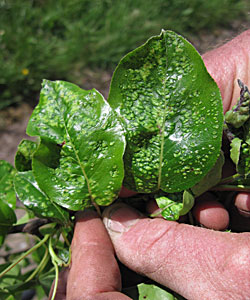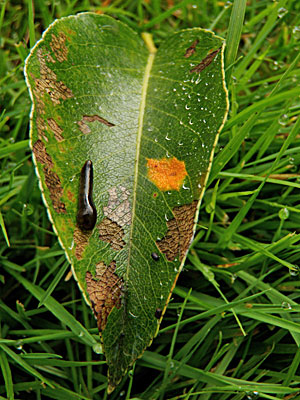
Leaf with pear blister mite
We’re hearing that many people are seeing problems on their pear trees this year. One pest that seems to be showing up is pear blister mite. This little mite overwinters in the bud scales on the trees, waking up as the trees break dormancy, then feeding on the leaves during the growing season. Because the mite lives in between the leaf surfaces, it cannot be sprayed for during the growing season.
For healthy trees, pear blister mite is mostly cosmetic, as the leaves tend not to drop, and continue to have good chlorophyll for supplying the tree energy. For young trees, it is important to make sure the trees are not stressed during the growing season at all if they show signs of blister mite- this means making sure they do not become drought stressed, and aren’t subject to other pest or disease pressures. If you do see blister mite on your pears, plan to spray with sulfur plus oil in the fall at leaf drop, then again next spring at bud break. If you do regular oil plus sulfur sprays at bud break on your pears, you may never see this pest.

Pear trellis rust (orange spot) and pear slug
The second issue to watch for on your pears is one I’ve blogged about before; pear trellis rust. This disease appears in summer as orange spots first, which then develop a brown center. On the back of the leaf a ladder like fruiting body forms, and releases spores in late summer which then infect the alternate host, which are some species of juniper. Those junipers’ infections mature over the winter, releasing spores in the spring to infect the pear foliage.
Pear trellis rust can weaken your pear trees left unchecked. Unfortunately, the only way to get rid of pear trellis rust is to get rid of infected junipers. That may not be possible if the junipers are not on your property. There is no really effective spray for the disease, although copper at leaf fall can help slow the spread. Pick off any leaves that show the orange spots, and try to do that early, before the fruiting bodies form. Dispose of the leaves in the garbage, not the compost pile. Juniperus communis and J. squamata do not act as hosts, so those are safe to plant.
The other critter apparent on the pear leaf above is a sawfly larvae commonly known as pear slug. This larvae eats the top leaf surface on pear and cherry trees. On mature, healthy trees, the damage is cosmetic. On newly planted trees, you should try to control it- pick them off, or dust with diatomaceous earth. Neem oil and spinosad are also effective.


Excellent procedure you share on this page of removing a pear-trees-problems by providing a pure tested water and also spread a medicine of root fertilization disease in a garden for the removing of stressed during the growing of trees , Which help you to save the tree from the disease comming during the root filtration of trees in a public garden after reading and remember the excellent points especially “ Pear trellis rust ”are mentioned in the great passage of information.
Thanks
We moved into a house with a pear tree. It produced quite a few pears but they haven’t grown much in size, are very hard, and are definitely unwilling to let go of their stems when held horizontally. Many of them have dried up and rotted. We have had plenty of rain and a fairly mild summer for Missouri. Don’t know what the problem is. The tree doesn’t appear to have pests either.
This doesn’t sound like a problem I have seen here. You might check with your local agricultural extension office or Master Gardeners for local knowledge on pears in your region.
We have mature pear trees in Bellingham that are plagued by PTR every year. Picking leaves off has become untenable (>50% of leaves get it. Maybe even >75%). Is it hopeless? Should we tearfully cut them down and plant something else? Is there any spray that might realistically help a little? I have sprayed copper in the past and will try that again… neem oil is reputed to be anti-rust… has it been tested against PTR?
I just saw that your PDF also mentions Serenade and Monterey Complete Disease Control. Is “Serenade” the same as “Serenade Garden”?
We’ll try those as well… unfortunately juniper bush management is not an option around here. 🙂
There is no truly curative treatment for PTR, although Serenade Garden spray can slow it. Without juniper removal, you will battle it as long as the trees are there (and the junipers are still there- they also decline from this disease). If you remove the trees, you can plant other fruit trees as this only affects pears.
Thanks Terry — if we can just reduce the number of infected leaves somewhat it might make it feasible to remove them by hand. I’ll give Serenade Garden a try. Do you know if tank-mixing Bt spray with Serenade is advisable? Often in the spring we only have a few precious windows between rain to spray Bt (which is crucial for the pears), and it would be hard to choose between Serenade and Bt… doing both at once would be great.
I don’t know if you can mix the 2 products, but it should say if it is allowable on the label. I know Bt can be mixed with other fungicides.